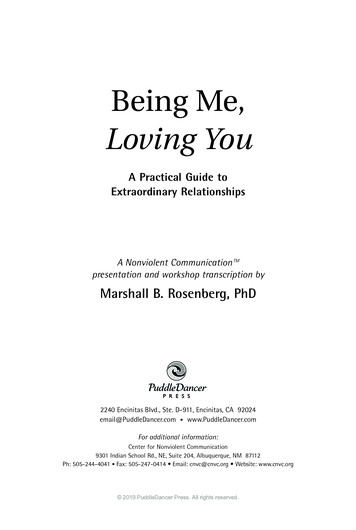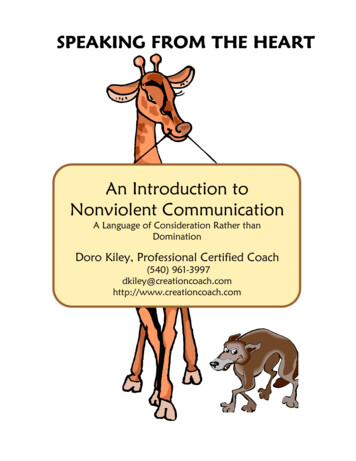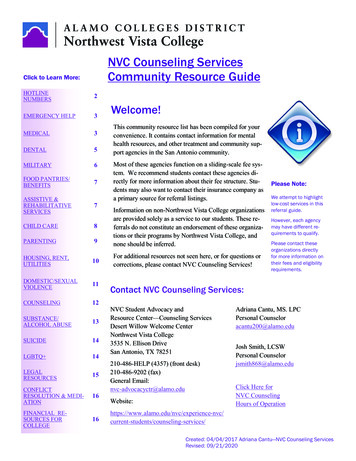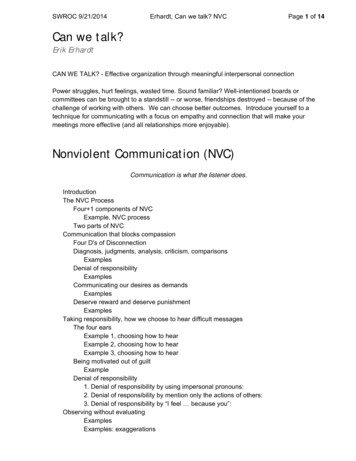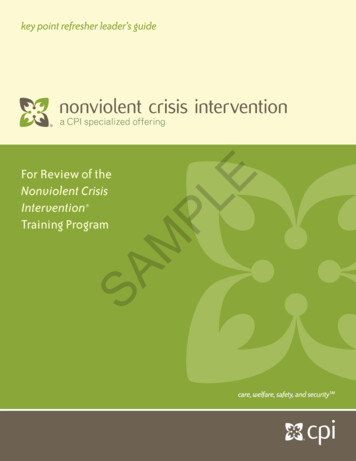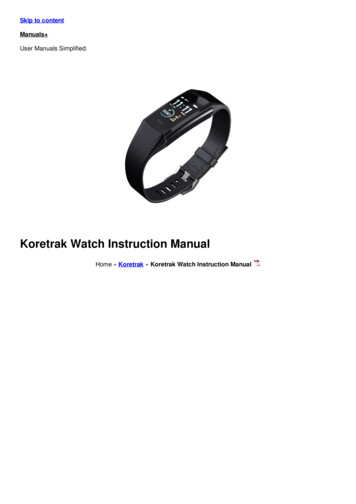
Transcription
NVC Instruction Guide(Note: Much of the information in this instruction guide draws extensively from thework of Marshall B. Rosenberg, Ph.D. as presented in his book, NonviolentCommunication: A Language of Life. We strongly recommend that the best way tolearn about Nonviolent Communication is to read the book and use the workbook incombination with this guide, as well as find a group of people with whom to practicethese important skills. Throughout each section of this guide you will findreferences to particular sections from the book or from Lucy Leu’s CompanionWorkbook. – Jiva Manske)Introduction: Nonviolence and NVCWe live in a world in which violence has become more and more acceptedas the norm. It’s all around us. From wars between nations to crime on the street,and even imposing on our everyday existence, violence manifests itself bothexplicitly and implicitly. Yet for many people, the very idea of violence seemsforeign. They are not involved in physical confrontations or abuses, and thus theybelieve that violence is not present. But the reality is that whenever we becomedisconnected from our compassionate nature, whenever our hearts are not devoidof hatred in all of its forms, we have a tendency to act in ways that can cause painfor everyone in our lives, including ourselves.Nonviolence, then, does not refer to the mere absence of physical harm. Itis a way of life that takes its lead from a compassionate and connected heart, andcan guide us toward a more complete and happy way of being. As MahatmaGandhi said, “Nonviolence is not a garment to be put on and off at will. Its seat isin the heart, and it must be an inseparable part of our very being.” It is a practicerooted in understanding, in living honestly, and in acting empathically with allbeings. Of course this starts with the self. We must first understand and actempathically towards ourselves in order to impact the world in wonderful andcompassionate ways. This means cultivating nonviolence in every action andbeing present to our own needs and feelings in each and every moment.Marshall Rosenberg realized the importance of nonviolence in every daylife throughout his childhood and on into his adult and professional life. Heunderstood how nonviolence could affect the world through the individual andthrough nurturing relationships on a personal level. Because of his experience withclinical psychology, comparative religion, and mediation, he was able to createNonviolent Communication (NVC) as a very simple model for transformingeveryday existence and for practicing nonviolence. His trainings, which began inthe 1960’s, eventually grew into an institution, the Center for NVC, which wascreated in 1984 and which remains a vital resource for a turbulent world.-1-
What is NVC? (Read Nonviolent Communication: A Language of Life, Chapter 1)NVC is a “language of life” that helps us to transform old patterns ofdefensiveness and aggressiveness into compassion and empathy and to improve thequality of all of our relationships. Studying and practicing NVC creates afoundation for learning about ourselves and our relationships in every moment, andhelps us to remain focused on what is happening right here, right now. Although itis a model for communication, NVC helps us to realize just how importantconnection is in our lives. In fact, having the intention to connect with ourselvesand others is one of the most important goals of practicing and living NVC. Welive our lives from moment to moment, yet most of the time we are on autopilot,reacting out of habit rather than out of awareness and presence of mind. Bycreating a space for attention and respect in every moment, NVC helps create apathway and a practice that is accessible and approachable.The ModelThe basic model for NVC is really quite straightforward and simple. It isa process that combines four components with two parts. While the fourcomponents are specific ideas and actions that fit into the form and the model ofNVC, the two parts provide a solid foundation for NVC as well as for livingnonviolently. They are the basis for Marshall’s ideas of giving and receiving fromthe heart. These brief definitions will be expounded further in the sections below:Four Components1. Observation: Observation without evaluation consists of noticingconcrete things and actions around us. We learn to distinguishbetween judgment and what we sense in the present moment, and tosimply observe what is there.1. Feeling: When we notice things around us, we inevitably experiencevarying emotions and physical sensations in each particular moment.Here, distinguishing feelings from thoughts is an essential step to theNVC process.1. Needs: All individuals have needs and values that sustain and enrichtheir lives. When those needs are met, we experience comfortablefeelings, like happiness or peacefulness, and when they are not, weexperience uncomfortable feelings, like frustration. Understandingthat we, as well as those around us, have these needs is perhaps themost important step in learning to practice NVC and to liveempathically.1. Request: To make clear and present requests is crucial to NVC’s-2-
transformative mission. When we learn to request concrete actionsthat can be carried out in the present moment, we begin to find waysto cooperatively and creatively ensure that everyone’s needs are met.Two Parts1. Empathy: Receiving from the heart creates a means to connect withothers and share experiences in a truly life enriching way. Empathygoes beyond compassion, allowing us to put ourselves into another’sshoes to sense the same feelings and understand the same needs; inessence, being open and available to what is alive in others. It alsogives us the means to remain present to and aware of our own needsand the needs of others even in extreme situations that are oftendifficult to handle.1. Honesty: Giving from the heart has its root in honesty. Honestybegins with truly understanding ourselves and our own needs, andbeing in tune with what is alive in us in the present moment. Whenwe learn to give ourselves empathy, we can start to break down thebarriers to communication that keep us from connecting with others.From these four components and two parts, Marshall has created a modelfor life enriching communication that can be highly effective in solving conflictwith our family members, with our friends, with our coworkers, and withourselves. The basic outline of the model is the following:When I see thatI feelbecause my need for is/is not met.Would you be willing to ?Keep in mind that this is just a model, and that using this form and thislanguage is not the most important aspect of NVC. In fact, as you practice moreand learn more, you’ll begin to notice that all four of these components can bepresent in the complete absence of the form.Learning and Using NVCLike nonviolence, itself, NVC is a practice that we must constantly pursueand refine. This guide is meant to present NVC in a simple and clear way that isaccessible to everybody who is interested in the mission and projects of the PeaceArmy of Costa Rica. For beginners, we recommend that you work slowly,carefully, and consciously through each chapter, spending a week on each so that-3-
you can integrate the information and the model into your being. We recommendthat if you are familiar with NVC, it is still important to review the basic ideas ofthe model now and again, and we have also tried to provide sections on specificsituations that come up in everyday life. Yet because this presentation is so simpleit is important to use other resources in conjuncture with practice groups andtraining sessions. The primary resources that you will need for introducingyourself to NVC are the following:Leu, Lucy. Nonviolent Communication: Companion Workbook. Encinitas, CA:PuddleDancer Press, 2003.Rosenberg, Marshall. Nonviolent Communication: A Language of Life.Encinitas, CA: PuddleDancer Press, 2003.You can get these resources
-1- NVC Instruction Guide (Note: Much of the information in this instruction guide draws extensively from the work of Marshall B. Rosenberg, Ph.D. as presented in his book, Nonviolent

